Ovicidal and toxicological effect of hydroalcoholic extracts of Euphorbia milli var splendens, Synadenium carinatum Boiss and Tagetes minuta L. against Ancylostoma spp.: In vitro study
- PMID: 33746411
- PMCID: PMC7921239
- DOI: 10.1007/s12639-020-01302-9
Ovicidal and toxicological effect of hydroalcoholic extracts of Euphorbia milli var splendens, Synadenium carinatum Boiss and Tagetes minuta L. against Ancylostoma spp.: In vitro study
Abstract
Nematodes of the Ancylostomidae family consist of important parasitic species. The control of such parasitosis represents an important challenge, given the constant high rate of reinfection of some hosts, among which the domestic dog, as well as the high environmental contamination. Another factor that can have a negative influence is the toxicity of the chemicals used for environmental decontamination, highlighting the need to design research to identify new control strategies for this parasitosis, among which the use of plant extracts. Thus, the objective of this research was to evaluate the toxicity and ovicidal activity of hydroalcoholic extracts obtained by percolation of three plants: Tagetes minuta L., Euphorbia milli var splendens (Bojer ex Hook.) Ursch & Leandri and Synadenium carinatum Boiss, against Ancylostoma spp. In addition, these extracts were tested at different concentrations for toxicity against Artemia salina L. and Allium cepa L. It was observed that the hydroalcoholic extract of all plant species evaluated induced moderate ovicide activity at all the tested concentration, with emphasis on E. milii, which was the only plant species that presented significantly low toxicity in the concentration of 12.5 µL/mL when compared to the other species evaluated.
Keywords: Ancylostoma spp; Environmental contamination; Plant extracts; Toxicity.
© Indian Society for Parasitology 2020.
Conflict of interest statement
Conflict of interestAll authors declare that: 1. The manuscript was not submitted to other journal; 2. The work is original; 3. There isn’t any plagiarism; 4. Results are presented without fabrication, falsification or inappropriate data manipulation. 5. All the results obtained are disposed in this publication, that is, it was not splitted out.
Figures




Similar articles
-
Ovicidal activity of the hydroalcoholic extract of Brazilian peppertree (Schinus terebinthifolia Raddi) against Ancylostoma spp. from naturally parasitized dogs.Nat Prod Res. 2022 Nov;36(22):5899-5903. doi: 10.1080/14786419.2021.2023145. Epub 2021 Dec 31. Nat Prod Res. 2022. PMID: 34969328
-
Photodynamic activity of Tagetes minuta extracts against superficial fungal infections.Med Mycol. 2020 Aug 1;58(6):797-809. doi: 10.1093/mmy/myz114. Med Mycol. 2020. PMID: 31724710
-
Physiological changes in Biomphalaria glabrata Say, 1818 (Pulmonata: Planorbidae) caused by sub-lethal concentrations of the latex of Euphorbia splendens var. hislopii N.E.B (Euphorbiaceae).Mem Inst Oswaldo Cruz. 2006 Feb;101(1):3-8. doi: 10.1590/s0074-02762006000100002. Epub 2006 Mar 30. Mem Inst Oswaldo Cruz. 2006. PMID: 16612505
-
Ovicidal and larvicidal effects of extracts from leaves of Andrographis paniculata (Burm. f.) Wall.ex Nees against field isolates of human hookworm (Ancylostoma duodenale).J Ethnopharmacol. 2019 May 10;235:489-500. doi: 10.1016/j.jep.2019.02.021. Epub 2019 Feb 11. J Ethnopharmacol. 2019. PMID: 30763693
-
Adulticidal, repellent, and ovicidal properties of indigenous plant extracts against the malarial vector, Anopheles stephensi (Diptera: Culicidae).Parasitol Res. 2013 Feb;112(2):679-92. doi: 10.1007/s00436-012-3185-2. Epub 2012 Nov 29. Parasitol Res. 2013. PMID: 23192528
References
-
- Afonso-Cardoso SR, Rodrigues FH, Gomes MA, Silva AG, Rocha A, Guimaraes AH, Candeloro I, Favoreto S, Jr, Ferreira MS, de Souza MA. Protective effect of lectin from Synadenium carinatum on Leishmania amazonensis infection in BALB/c mice. Korean J Parasitol. 2007;45(4):255–266. doi: 10.3347/kjp.2007.45.4.255. - DOI - PMC - PubMed
-
- Araújo GL, Campos MAA, Valente MAS, Silva SCT, França FD, Chaves MM, Tagliati CA. Alternative methods in toxicity testing: the current approach. Braz J Pharm Sci. 2014;50(1):55–62. doi: 10.1590/S1984-82502011000100005. - DOI
-
- Cardoso MR, Mota CM, Ribeiro DP, Noleto PG, Andrade WB, Souza MA, Silva NM, Mineo TW, Mineo JR, Silva DA. Adjuvant and immunostimulatory effects of a D-galactose-binding lectin from Synadenium carinatum latex (ScLL) in the mouse model of vaccination against neosporosis. Vet Res. 2012;43(1):76. doi: 10.1186/1297-9716-43-76. - DOI - PMC - PubMed
-
- Ciappina AL, Ferreira FA, Pereira IR, Sousa TR, Matos FS, Melo-Reis PR, Gonçalves PJ, Bailão EFLC, Almeida LM. Toxicity of Jatropha curcas L. Latex in Allium cepa test. Biosci J. 2017;33(5):1295–1304. doi: 10.14393/BJ-v33n5a2017-33835. - DOI
LinkOut - more resources
Full Text Sources
Miscellaneous
